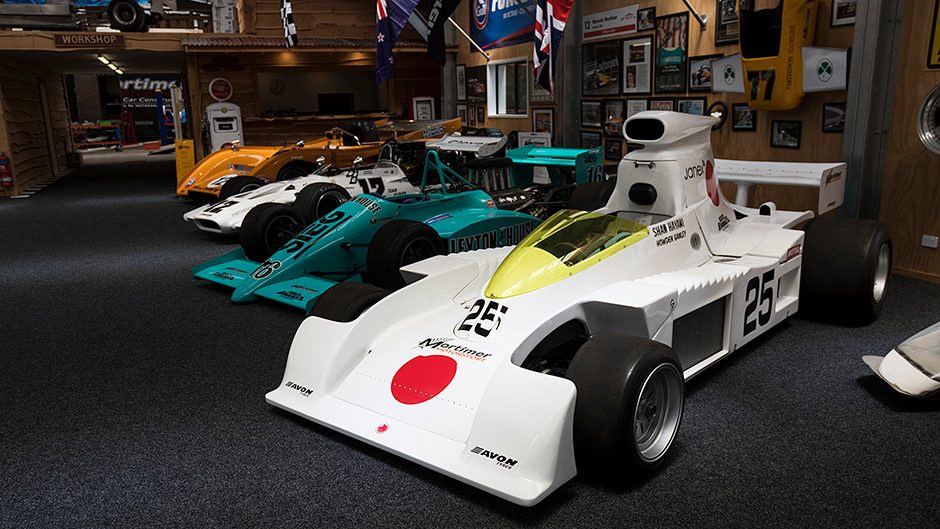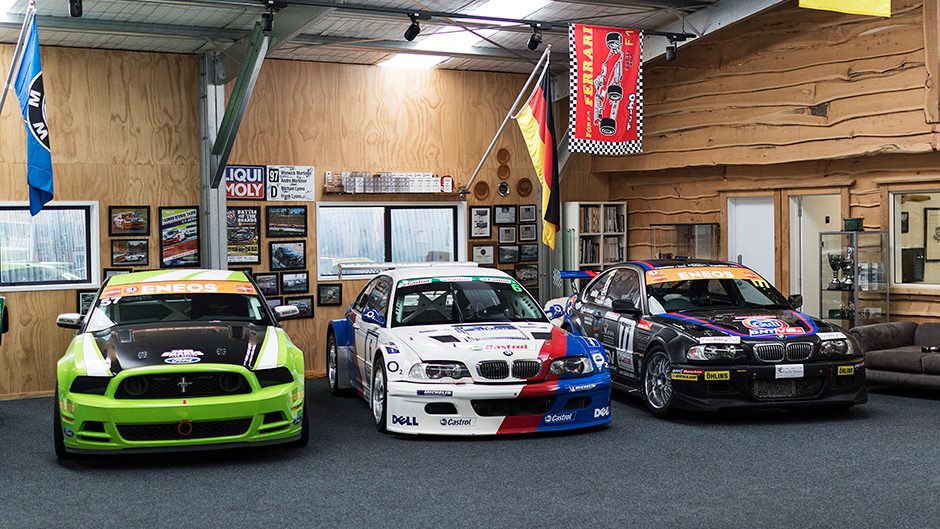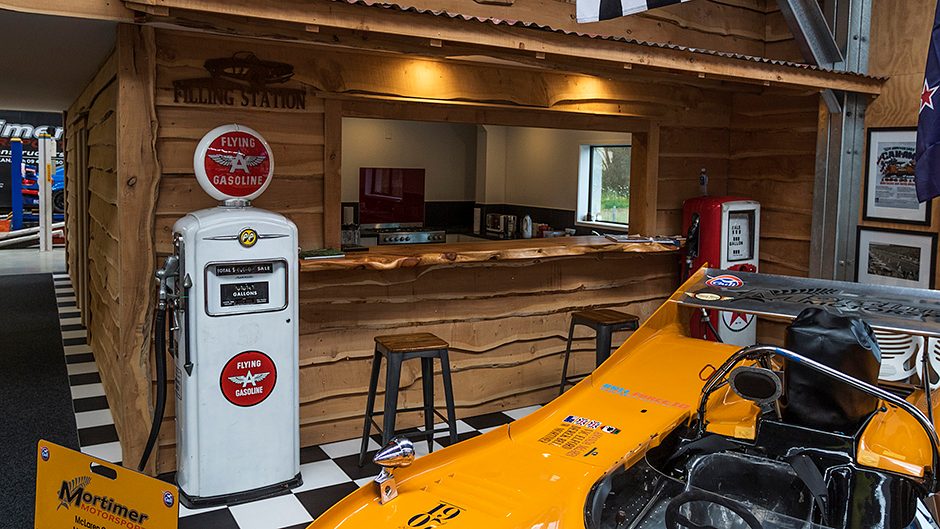Mortimer Motorsport – The jewel of the north
Words Richard Opie | Photos Richard Opie
New Zealand is blessed with great collections celebrating the sometimes weird and wonderful world of motorsport. One such horde hides away in Northland in the custody of Mortimer Motorsport.
There is an extensive array of extremely special motor vehicles that pepper this country. We are talking cars of proper provenance, dripping in intrigue, many with connections to superstar drivers, both local and beyond. Just north of Matakana one such assortment of esteemed race hardware exists in the Mortimer Motorsport collection. The Mortimer Motorsport name has been linked more recently with their string of wins and titles competing in the BMW Race Series. However, for Warwick Mortimer, founder and patriarch of the family collection, the origins stretch back decades.
The story begins on a tropical kart track. More accurately, an airfield in Rarotonga (his father was the local agent for Honda cars and bikes) where Warwick and his mates whetted their appetite for motorsport at the wheel of home-made karts. The karting continued on his return to New Zealand at the Mount Wellington dirt track before he obtained a driver’s license and got into rallying at a club level. Belting around in a Mini Cooper in the late sixties saw Warwick compete against many future household names of Kiwi rallying. Dabbles in circuit racing followed, before marriage and a shift back to the islands, Port Vila to be precise, heralded another change.

Warwick recalls it as a fantastic period, rallying in Vanuatu at the wheel of a Corolla belonging to Kiwi speedway legend Reece Discombe. They even formed a dirt circuit as well as a local car club, and eventually the RA28 Celica that sits in the collection today was pressed into service as a rally/race machine. Competition in the one-make Escort Sport series of the late 1970s followed on his return to New Zealand, and the Celica was spirited across from Vanuatu. This car was prepared for circuit duties by Jim Donald, Peter Davidson, and Allan Draper of Masport fame, and it ran in the Benson & Hedges production endurance races.
It’s clearly a special car amongst the collection, even though its history is a little less sparkling than many of its shed mates. An ex-Allan Grice Commodore also graces the Mortimer fleet, and another he speaks fondly of is an ex-Yoshimi Katayama Mazda RX-7. With a 13B peripheral port providing motivation Warwick ran against sports sedan heavyweights of the time. The Mazda lacked the straight line pace of the thundering V8s, but nimbleness proved a virtue through the tight stuff.
The addition of the Japanese race cars in recent times stems from the relationship between the Mortimers and their Japanese business connections. It’s difficult to acquire these cars without the right relationship. It began from those early days of the Honda agency in Rarotonga. The buying of Honda stock was directed through a Japanese firm, Yamato Industrial, which granted Warwick’s father a trip to Japan as a reward for selling the most Honda motorcycles per head of population.

A mutual love of motorsport was discovered, and he found himself running a race meeting at Suzuka in the then-new Honda S600. He won both races, kick-starting the motorsport relationship between the Mortimers and Japan. Warwick took over the business in the early 1980s, maintaining the relationship with Yamato Industrial and importing automotive parts. During visits throughout the 1980s Warwick struck up friendships with some key motorsport folk, including Katayama himself. This resulted in the acquisition of the RX-7, as well as the notable March-Mazda 84G Group C racer. This association is now into its third generation as Warwick’s son Andre now handles the relationship, and this has recently proven fruitful with the importation of yet more notable race cars.
The BMWs now hold the focus of the Mortimer Motorsport operation, the new Matakana facility with four Dinan-engined 3 Series-based racers, campaigned in everything from the BMW Race Series to Kiwi endurance racing, and even a sniff of class success at the Bathurst 12hr race. The facility includes a workshop with two full-time engineers splitting their time between the BMWs and the classic hardware. But Warwick still places a particular emphasis on holding on to historic racers with provenance, especially those with a Kiwi bent. It’s a finely curated collection, set to grow, but not destined to spend days gathering dust. Ensuring the Kiwi public has the opportunity to see, feel and breathe classic motorsport, the Mortimer’s dedication to keeping the cars where they’re meant to be – on the race track – is admirable.
1969 Surtees TS5 Formula 5000
In 1969, John Surtees took over a small Formula 5000 concern run by Englishman Len Terry, which culminated in the Surtees F5000 chassis, the TS5. The first of these sold offshore by Surtees, TS5/002, now sits in the Mortimer collection. The offshore owner? Film star James Garner, as one of his two-car American International Racing (AIR) team. These were run for eight months in the US Formula 5000 series before Garner changed his focus and the cars were sold back to Surtees. It then saw service in South Africa with local ace Jackie Pretorious in the 1970 season.
Sporadic ownership followed – it was simply an old race car by that stage. The TS5 even saw very brief action as a drag car, before a clash with the wall on its first pass saw it resigned to a shed for 22 years. Resurrected in 2003, the car was spirited back to England by Anthony Smith who undertook a thorough restoration. At this point, the racer was rejuventated in its yellow and white South African livery, with the correct 302 cubic inch engine reinstated.
These early F5000s are arguably more beautiful than their later counterparts, with the cigar-shaped tubs free of the later aerodynamic development that lead to much fussier lines. This was the first historic car Warwick brought back to New Zealand, following a trip to England in 2009. Since then, Warwick has campaigned the car throughout New Zealand, as well as in the Australian Grand Prix meeting, and Oulton Park in the UK.
1974 Maki F101
Acquired from the estate of a Japanese business acquaintance, the Maki F101 represents a Kiwi connection to Japanese motorsport in another historically significant manner.
In 1974, a small group of Japanese engineers and designers, fronted by Kenji Mimura, made their Formula 1 debut at the British Grand Prix. For the Japanese it was an especially auspicious occasion. The Maki team was the first to emerge from Japan to contest the category since Honda withdrew in 1968. Kiwi driver Howden Ganley was sought out by the team, and soon enough Mimura, designer Masao Ono and their small team of engineers had moved into Ganley’s garage. The result was the F101. Stylistically, it employed many elements consistent with the era, no radical design or engineering features. The engine was the ubiquitous Cosworth DFV 3.0-litre, and with this the team hit their first Grand Prix at Brands Hatch. Sadly the car proved overweight to the tune of around 100kg, lacking in straight line speed and even worse it was fragile.
Ganley missed out on a starting grid spot by just over a second, but in his defence he didn’t have the opportunity to string many laps together. Two weeks later, at the Nürburgring, the Maki team fronted again. However, this time a rear suspension failure on Ganley’s first qualifying lap ended with the F101 in the barrier. The subsequent leg injuries ended Ganley’s career, along with the Maki’s season. It did reappear with various changes and in different guises for the following season but ultimately never made a race start.
Nonetheless, it’s an interesting facet of F1 history, and negotiation of Mortimer’s purchase came about when the Japanese owner of the car, a friend, requested that Warwick arrange for Ganley to drive the car at the 2014 Goodwood Festival of Speed. The Kiwi end of the arrangement was upheld, and in response the Japanese connections ensured the car made it to New Zealand earlier this year.
The plan?
Kiwi motorsport fans will definitely get the chance to see the Maki in action, and ultimately Warwick and the team plan to race in Monaco at the 2018 Classic Grand Prix.
1984 March 84G Mazda
Although currently a work in progress, one of the most exciting cars of the Mortimer line-up is the March 84G Group C racer. Group C is enjoying a renaissance in world historic racing and this car is a relatively important part of Mazda’s history. Before the 84G, Mazda’s sports car campaign had revolved around the naturally aspirated twin-rotor engine.
Ultimately, despite all efforts, getting much more than 300hp out of the compact powerplant proved fruitless. The result was the adoption of turbocharging for the twin-rotor. Although heat management required overcoming, the net result was power levels in the 500hp area, satisfying Mazda management enough to wedge the engine into a purchased March 84G. The March-Mazda hybrid competed in the 1984 Fuji 1000 with Yoshimi Katayama partnering with Takashi Yorino, but failed to go the distance.
It remains the only turbocharged sports car racer produced by Mazda, and ultimately gave the impetus to develop the quad-rotor Le Mans-winning engine. Katayama, as thanks for his efforts in Mazda’s motorsport programme, was presented with the 84G. The car then sat on display at his dealership, and was stored outside for a number of years. It survived the 1995 Kobe earthquake, although the associated spares package was crushed beneath a motorway overpass. The Mortimers obtained the car in 2015, the result of a cheeky request some years back when Warwick first encountered the car in Japan. When Katayama’s health began to deteriorate, the offer was made and duly accepted.
It now resembles an immaculate bare tub, expertly rejuvenated by the Mortimer Motorsport team. Almost every component is ready to reassemble, in a fashion sympathetic to period. Again, Kiwi track time is planned so keep your eyes peeled for this piece of rotary history circulating in the not-too-distant future.
1971 McLaren M8E/F
Much has been written already about the McLaren domination of Can Am racing in the USA, solely at the hands of the M8 in its various iterations.
The Mortimer beast represents the end of the evolution for the M8 chassis. As an M8E, updated to F specification, the McLaren sports an alloy Reynolds block displacing 8.3 litres, and churning out around 825hp in its current form. It’s mechanically injected with a Kinsler fuel injection system, and in typical Can Am form tucks massive slicks beneath swooping panels. Its history includes a start with American driver Ed Felter, being campaigned in the ’72 and ’73 seasons.
From there, it passed through a few hands before being crashed heavily. Restored by the Bryant family in the 1980s, the M8 saw time in the HSR Thundersports series with drivers like Vic Elford and Derek Bell taking the wheel. It’s a driving experience that Warwick describes as “Phenomenal. There’s so many things right with it, and that’s what Bruce McLaren did.” The chassis provides epic grip, and of course the prodigious torque of the big block enables a pair of black lines to chase the car up the tarmac at will.


































